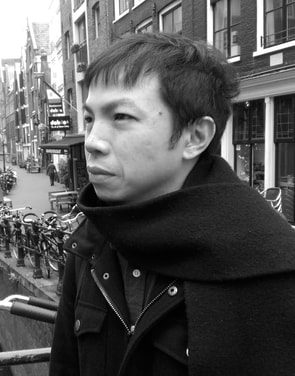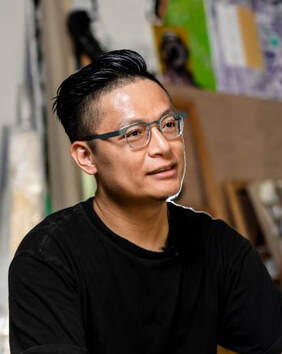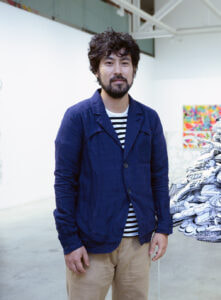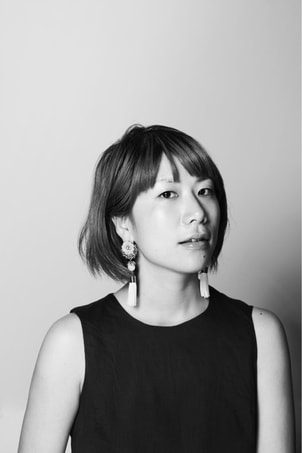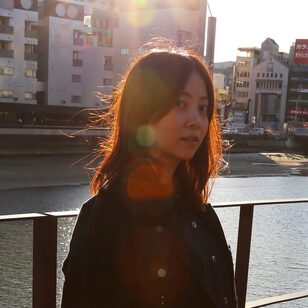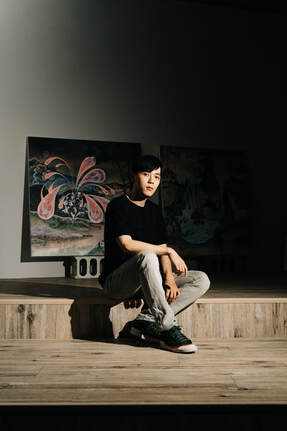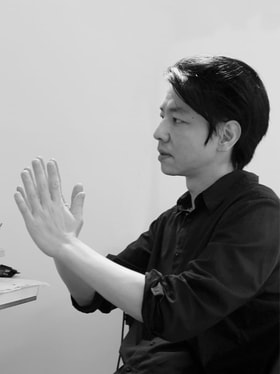ART TAIPEI 2023
Booth F03
2023.10.20- 2023.10.23
參展藝術家 Artist Introduction
|
Chao-Tsai CHIU 邱昭財
Teppei KANEUJI 金氏徹平 Yuko MOHRI 毛利悠子 Chihiro MORI 森千裕 |
Mu-Chi HSIEH 謝牧岐
Jing-Yun OU 歐靜雲 Sean WANG 王璽安 |
|
Chao-Tsai CHIU 邱昭財
b. 1977 邱昭財的作品以「類似於玩具的互動機制」作為創作發展的主要概念,運用發條動力,結合生活中觀察的片段或是抽象造型場景如:愛的鼓勵拍手的手勢、不停攀爬但終究掉落的珠子(如同薛西佛斯推巨石的人生)等,使用動態標本形式呈現,再以玻璃鐘罩將他們保存下來。試圖藉由玩心的引領觀者觸動來開啟作品的動態,透過互動操作的過程延伸自身的身體成為機械的一部分,幫助發條機械嘎嘎運轉的同時跳脫現實,反覆進出屬於日常,卻又不尋常的發條世界。目前正於就在藝術空間舉辦個展,並於2022年獲得藝術未來行動專案獎助。 Chiu Chao-Tsai focuses on "interaction mechanism" as his main concept of creation, using clockwork mechanism, combined with fragments of observation from the daily life or abstract models, such as the ‘‘Encouragement of Love’’ clapping gestures; the constantly climbing beads but eventually will fall down the slope bead (like the life of Sisyphus pushing a boulder), etc. The artist turns movements into the form of dynamic specimens and then preserved them in the glass bell jars. "Clockwork Pattern" is activated by the viewer whose playfulness has driven them to play, to extend their cognition from one's own body to the machine. This action forms a cleft for the viewer to escape from reality, a passage of going back and forth in the typical yet peculiar clockwork land. |
|
Mu-Chi HSIEH 謝牧岐
b. 1981 謝牧岐過去的創作藉著個人的繪畫銜接在地環境與文化脈絡,本次將更專注於繪畫的「行為」本身,他認為畫布上呈現出的顏料的疊加、厚薄等表現其實關乎了繪畫的過程、工法、乃至於創作者自身處於怎樣的狀態。所以便提取了過去學習經驗中尋求不同的材質組合、拼貼、構成的經驗,以繪畫的邏輯與思考去嘗試使用刻版畫的方式顯現出位於畫面底層的顏色,以及編織一層一層堆疊出的顏料,使得顏料不只是疊加在畫布表面的材質,而是成為畫布。 Hsieh Mu-Chi's previous creations had been trying to form a connection between the artist himself and native, cultural development. Recently the artist shifts his focus to the “action” of painting. He believes that the layers and thickness of paint on the canvas are actually related to the painting process, construction methods, and even the state of the creator himself. The artist seeks the experience from past experiment, the different material combinations, collages and compositions, process with painting logic and consideration, he engraves out the depiction to show the color layered at the bottom; and weave the strips of dried paint into sheet to express a different aspect of paint, not just a supplement but becomes the canvas itself. |
|
Teppei KANEUJI 金氏徹平
b. 1978 日本當代藝術家金氏徹平擅長搜集並拆解生活中常見的日常物件,將其從通常的功能中釋放出來,透過組合起來的樣貌使觀者感到熟悉的同時也會感到一絲違和,因此從中賦予了這些物件新的意義和視覺聯想。本次將展出他的標誌性系列作品:「White Discharge」由覆蓋著黏稠的白色壓克力的塑膠人偶們組裝而成的雕塑。 Japanese contemporary artist Teppei Kaneuji is expert in collecting and dismantling common objects in life, releasing them from their usual functions. The viewers will find a familiarization and also disturbance in the combined appearance of the artwork, which has granted a new meanings and visual associations to these objects. This exhibiting will present his signature series of works: "White Discharge", sculptures assembled from plastic figures covered in white puffy-look acrylic. |
|
Yuko MOHRI 毛利悠子
b. 1980 毛利悠子的創作取材自生活觀察的細節,透過蒐集日常生活中的物件及各種機械零件,改造組合成的電子機械裝置來傳遞所體驗到的聲音或光線等無形的能量。她的創作脈絡持續探索環境中自然能源的流動與能量傳遞,並以「電路」或「循環」概念形成一個獨立有機的系統。除了曾於就在藝術空間舉辦過多次個展外,活躍於國際各大雙年展與美術館的展覽與藝博會。將於2024年「第60屆威尼斯國際美術雙年展」日本館參展藝術家。 Yuko Mohri’s creations are inspired by the fragment of life observation. She collects daily object and various mechanical parts, combines them in to electronic mechanical devices. Through the artworks the artist is able to express the experiences with intangible energy such as sound or light. A central motif within her work is a transfer of energy using the flow of natural forces in our environment, integrating with the concept of a ‘circuit’ or loop to form a self-contained organic system. Besides the several solo exhibition Yuko Mohri had held in Project Fulfill Art Space, she is also active in international exhibition, art fairs and biennales. In 2024, Yuko Mohri will be the exhibiting artist of Japanese Pavilion in the 60th Venice International Art Biennale. |
|
Chihiro MORI 森千裕
b. 1978 森千裕將城市常見的各種圖像,如顏色與線條鮮麗的招牌與廣告、運動比賽中運動員活躍的模樣、與人交談間突然冒出令人意想不到的話語,或者是電影中的場景以及孩童時期隨性塗鴉等日常碎片作為元素收集後,以自然而令人會心一笑的方式進行拼貼,創造出耐人尋味的作品。主要個展包括「omoide in my head」(豐田市立美術館,2017),亦被選為創作「2020東京殘奧會藝術海報」的藝術家之一。 Chihiro Mori combines various common images in the city, from signs and advertisements with bright colors and lines, unexpected words that come out of random passersby, or the active appearance of athletes in sports competitions, to scenes in movies and casual graffiti made by child. The artist collets these daily fragments as elements, assembles them in an intrinsic and laugh-inducing way to create thought-provoking works. Chihiro Mori’s most renowned solo exhibitions and works include "omoide in my head" (Toyota Municipal Art Museum, 2017). Chihiro Mori has also been selected as one of the artists to create the Art Poster for "2020 Tokyo Paralympic ". |
|
Jing-Yun OU 歐靜雲
b. 1991 歐靜雲汲取歷史敘事和神話想像之間人的精神交錯,以瑰麗幻變的畫面留給觀者與之呼應的探索空間。過去的創作主題多所觸及集體意識在歷史情結與神話寓言之間的感性糾結,他透過自然環境、人造生活以及事件現場矯飾地構築出一式開放的敘事圖譜,以繪畫視窗造就滿是激情的感官邀請,在色料與造型的殘跡中將現實不斷地從瑰麗的夢幻中翻攪而出,讓幻變的主體、空間在形與意的裂隙中獲得精神的逃逸。 Ou Jing-Yun precipitates human deliberation which intersects between historical narrative and mythological imagination, opens a space of exploration with splendid images. Most of the themes in his past creations touched on the emotional entanglement of collective consciousness between historical complexes and myths and fables. He constructed an open narrative map through the natural environment, artificial life and event scenes, and created a passionate sense through the painting. In the traces of color and shape, the reality is constantly stirred out of the brilliant dream, so that the shifting subject and space are able to has the spiritual escape through the gap between form and meaning. |
|
Sean WANG 王璽安
b. 1979 近期創作延續繪畫的形式進行著,王璽安著重的不僅是繪畫透過形象與技巧的特質;更多的是在這些技巧的特質背後的觀念,這與藝術家學習歷程中對於觀念藝術的認識有關,繪畫所呈現的不單是畫面的形象穿透,還有許多關乎於觀念的穿透:藝術作品能夠在感知中達到智性的思考,這應該是藝術經得起時間考驗的原因。 Sean Wang’s recent artworks continue to examine form within painting, focusing on both the expressive aspects of imagery and technique, as well as reflecting on the conceptual framework behind these technical qualities. This dual approach of both emotional and intellectual elements stems from Wang’s previous study of Conceptual Art. His art practice reflects painting as a visual language that penetrates our conscious thought; where our sensory experience informs our cognitive or intellectual understanding. This perceptual relationship could be considered as a fundamental factor towards the timelessness of art. |

